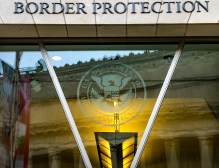Amid scrutiny into the US Secret Service, a look at how the agency uses technology

In the aftermath of an assassination attempt on former president and current Republican nominee Donald Trump, the United States Secret Service is facing heightened scrutiny over its operations and approach.
The law enforcement agency is currently facing several investigations into what happened and USSS Director Kim Cheatle was subpoenaed to testify at a House Oversight and Accountability Committee hearing Monday about the incident. The agency is also facing questions about how its robust budget is being put to use.
The Secret Service received $3.1 billion for fiscal year 2024 out of the Department of Homeland Security’s total base discretionary funding, a $265 million increase from FY2023. That topline figure includes $244 million specifically for candidate and convention protection in the 2024 presidential campaign and other special national security events. The Secret Service’s enterprise IT modernization budget, meanwhile, is $141.7 million.
Right now, there is no evidence that the assassination attempt had anything to do with a technology failure — and, right now, it’s not clear that the shooter left any indication of his plans online. Law enforcement have said that a search of the shooter’s online activity included the use of encrypted platforms, research into major depressive order, and searches related to both Trump and President Joe Biden.
The Secret Service did not answer a range of questions sent by FedScoop, specifically regarding the extent to which the USSS conducts social media monitoring, how it uses technology to monitor threats against officials, and which technology capabilities had been incorporated to deal with heightened campaign activity.
“Out of concern for operational security, the U.S. Secret Service does not discuss the means and methods used to conduct our protective operations,” the agency told FedScoop. “Questions regarding the investigation into the July 13 shooting in Pennsylvania should be directed to the FBI.”
The Secret Service’s chief technology officer and chief information officer did not respond to requests for comment. The police department for Bethel County, Pennsylvania, where the rally was held, did not respond to a range of questions sent by FedScoop, and referred any questions to the FBI during a phone call.
Additionally the Department of Justice and FBI did not respond to a request for comment, though the FBI said in a press release that the bureau’s technical specialists have accessed and are currently analyzing the electronic devices belonging to the shooter as of Monday.
Given increasing questions about the agency’s performance and growing concern about the safety of federal officials, FedScoop examined publicly available documents — including contract records, federal reports, and privacy impact assessments — to provide some examples about the kind of technology the Secret Service might have at its disposal to push back against these threats. Many of the companies mentioned did not respond to requests for comment.
Social media and online monitoring
The Secret Service appears to have used a series of services to monitor discourse online, based on online contract records, including Zignal Labs, an intelligence firm that can scan through online discourse for references to potential topics. In the past, the agency purchased licenses from the data mining services company Creative Radicals for social media threat monitoring. The USSS has also had contracts with Babel Street, a provider of open source intelligence. A contract with AT&T references the agency’s work conducting social media monitoring, too.
Secret Service documents obtained by Bloomberg provide insight into the USSS’ awareness of social media activity.
The Secret Service has also disclosed a social media screening contract through a privacy impact assessment. The contract focuses on scanning the social media of prospective and current employees of the USSS.
Back in 2019, the USSS opened its first-ever “round-the-clock” open source social media analysis unit, according to the agency’s 2023 annual report. That unit, according to the report, “shares relevant information with Secret Service leadership and operational personnel to inform investigations and protective activities.” Last year, the agency said it was opening its first-ever Open-Source Intelligence Operations Center.
Protective Threat Management System
According to an agency privacy impact assessment, the Secret Service uses a technology called the Protective Threat Management System. The tool functions as a case management system for tracking potential threats against those the USSS is charged with protecting. Information about potential threats might come from direct contact, reports, media discussion, or social media.
Documents obtained by Bloomberg also provide insight into the system, showing that when tracking threats, USSS paperwork can include an “FBI number” or a number that identifies individuals who have biometric data stored in the bureau’s nation-wide database of fingerprints and criminal records of those who have been arrested. According to those documents, case abstracts also include a list of uploaded documents pertaining to specific cases.
For example, one case referenced in the documents provides details about an individual that trespassed at Mar-a-Lago three times. The individual’s aliases and screen names are redacted, though their activity related to the former president on the social media site Gab is referenced.
Protective Intelligence eXchange
The Secret Service has said it uses a system called the Protective Intelligence eXchange program, a platform to track and manage threats. The tool is web-based and designed to collect information about people who have expressed an “inappropriate interest in a public official,” according to privacy impact assessment.
Local and state law enforcement are also involved in the service, though it’s not clear if Bethel Park police were connected to the system. The agency also has another tool, called the Field Investigative Reporting System, for gathering information and data during an investigation.
Commercial telemetry data
Last fall, the Secret Service was one of several DHS components flagged by the agency’s office of inspector general for its approach to purchasing commercial telemetry data, or phone location data. It’s not clear that the agency is still using this technology, as a privacy impact assessment for CTD is not listed on DHS’s page for the USSS. Back in January, the Secret Service told FedScoop that it had resolved the recommendation from the report.
Criminal investigative technologies
The Secret Service appears to have a contract worth tens of millions with a company called Ardent Management Consulting for criminal investigative technologies. It’s not clear what that service entails, but an Ardent MC website mentions location intelligence, digital transformation, and data analytics services. The contract is scheduled to end in August, according to the USA Spending website.
Artificial intelligence, robotics and drones
According to DHS’s publicly available AI inventory, the Secret Service has not disclosed any specific use cases of the technology. Still, there’s a facial recognition pilot for the White House complex publicly listed on DHS’s website for privacy paperwork related to the USSS. The agency has also disclosed the use of drones, which the director of the Secret Service confirmed in Monday’s hearing.
According to the Government Accountability Office, some members of the law enforcement agency were early users of Clearview AI, the AI-based facial recognition service that sparked controversy for collecting images of peoples’ faces from across the internet without their consent.
Secret Service officials told the GAO that leaders at the agency’s headquarters “were unaware that staff were using these services because staff were using free trial accounts.” Since then, officials have taken action to “prohibit staff use of free trials” and halted use. The GAO’s 2023 report stated that the agency stopped using the technology in 2020.
A closer look at Secret Service tech
As scrutiny into USSS mounts, it’s possible that the agency’s use of technology becomes a bigger source of discussion.
That there have been tech issues at the Secret Service is no secret. The USSS’ technological capabilities were the subject of GAO reports in 2018 and in 2022. These reports highlighted the service’s need to prioritize technological expertise and functions, and focus — in part — on budgetary needs to address this pitfall.
Many of the recommendations from the 2018 report have been implemented, including one that asked the USSS director to ensure that its CIO analyze the IT workforce to “identify its competency needs and any gaps it may have.”
But several remain open, including a recommendation for the USSS director, the Office of Human Resources and OCIO to “adjust recruitment and hiring plans and activities” as needed after implementing tracking metrics to evaluate the effectiveness of various workforce activities.
In its 2022 study, the GAO recommended that the Secret Service review and refresh its “technological footprint” and that the agency should “continue to receive dedicated funds for technology” in its own budget and in DHS’s science and tech budget to accomplish tasks.
The USSS told the watchdog at the time that a draft of the fiscal years 2021-2026 Strategic Implementation Plan for Protective Technologies — to address technical capabilities and future needs — had been completed but not finalized because it was in a pilot phase. The USSS did not answer a question from FedScoop about the current status of this pilot.






